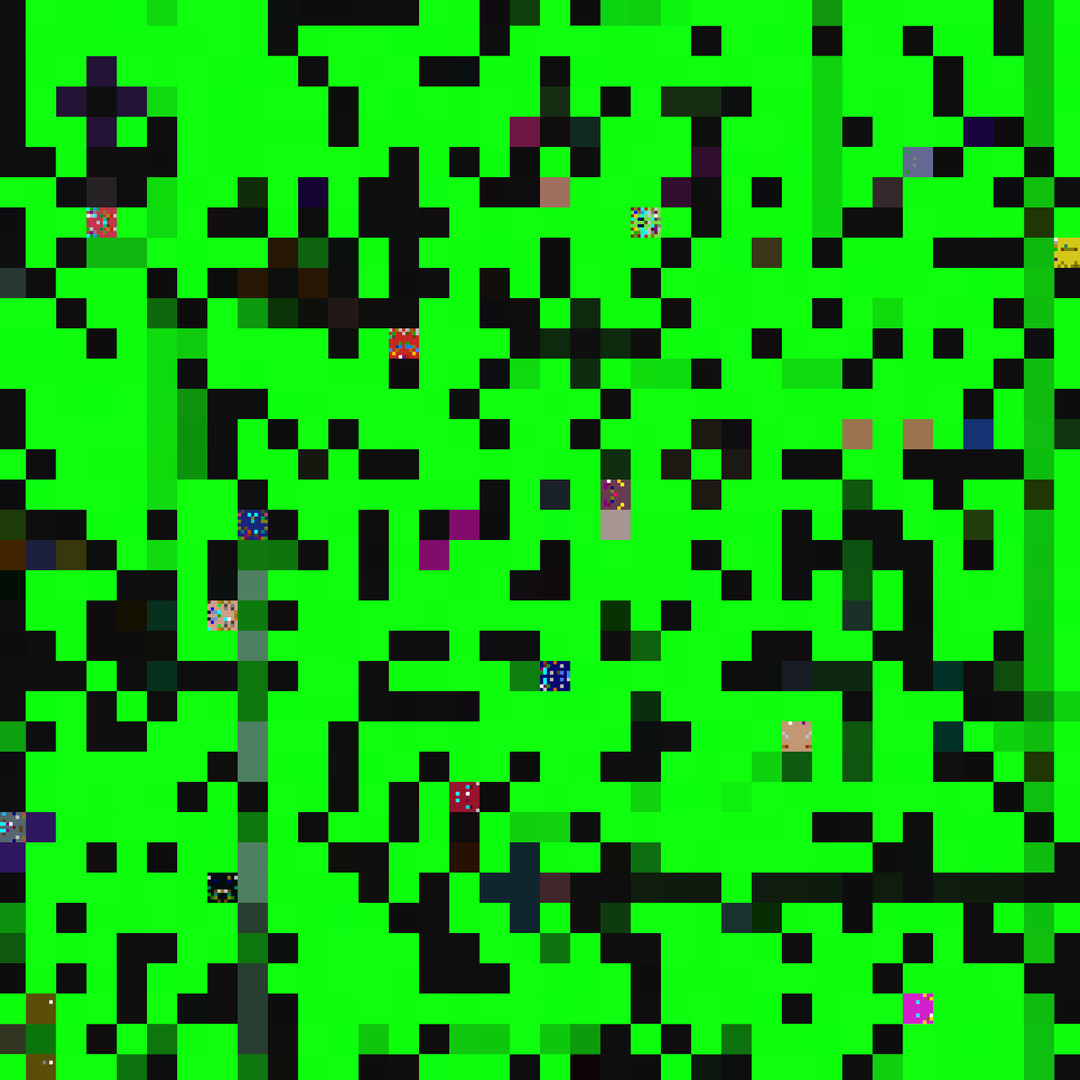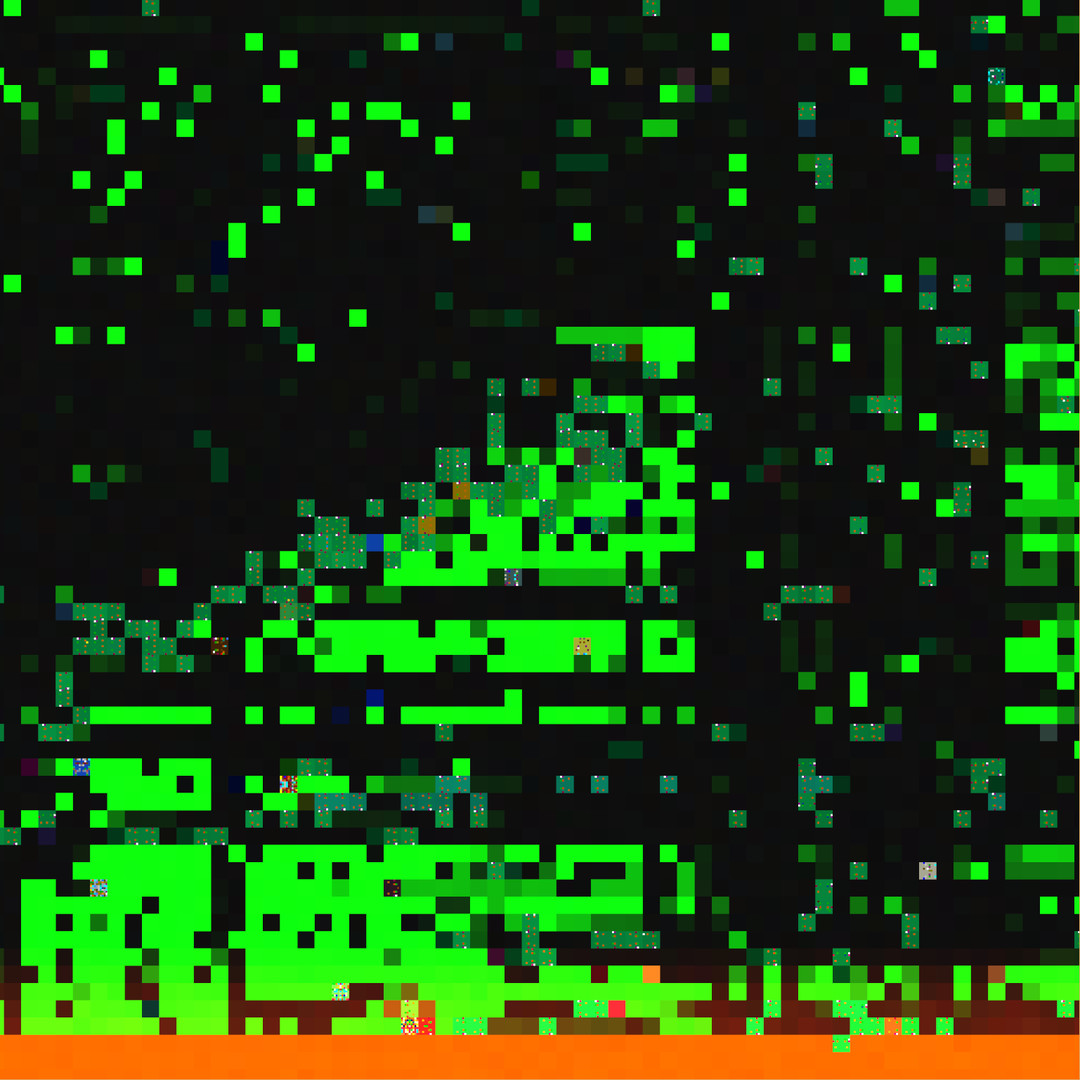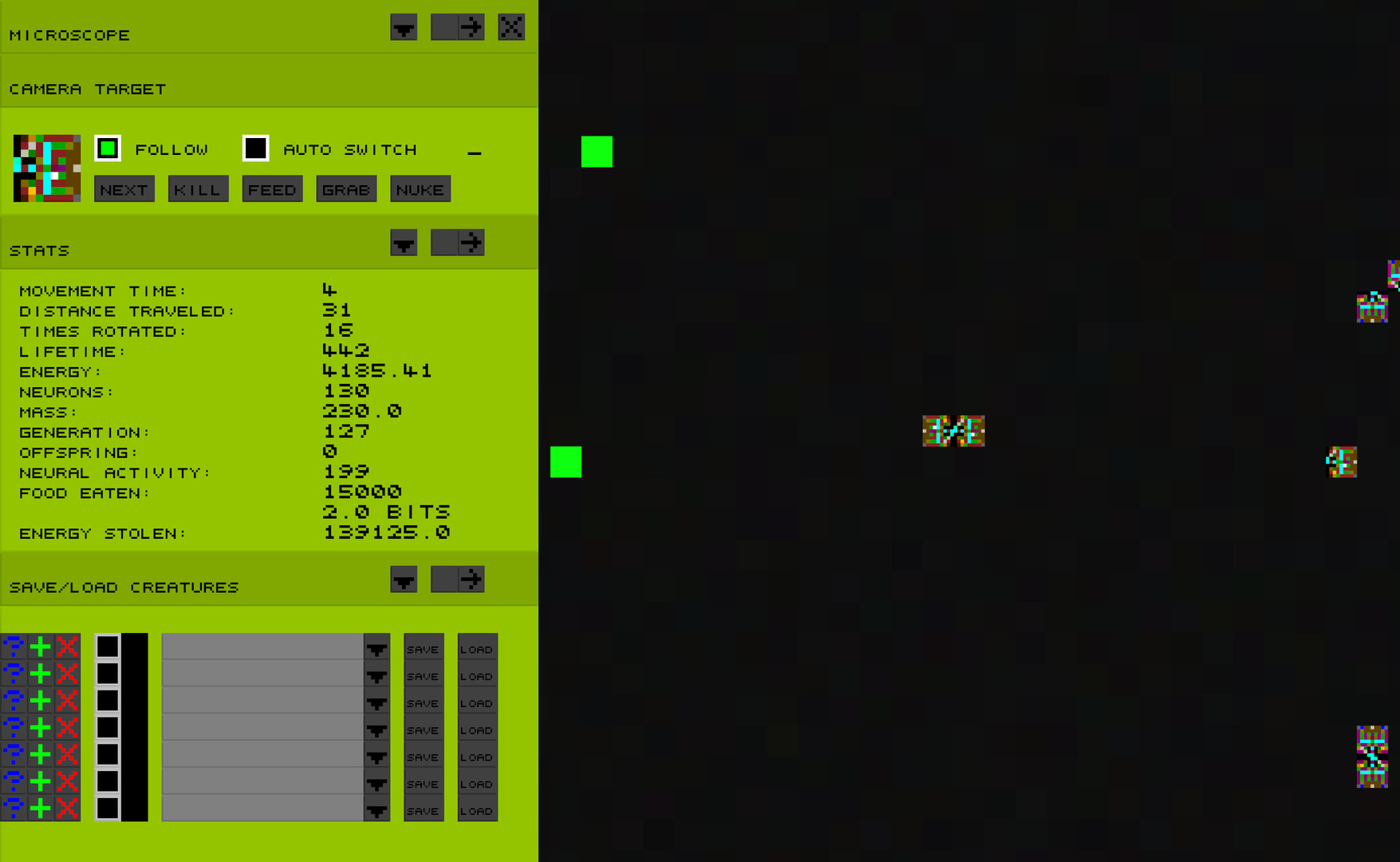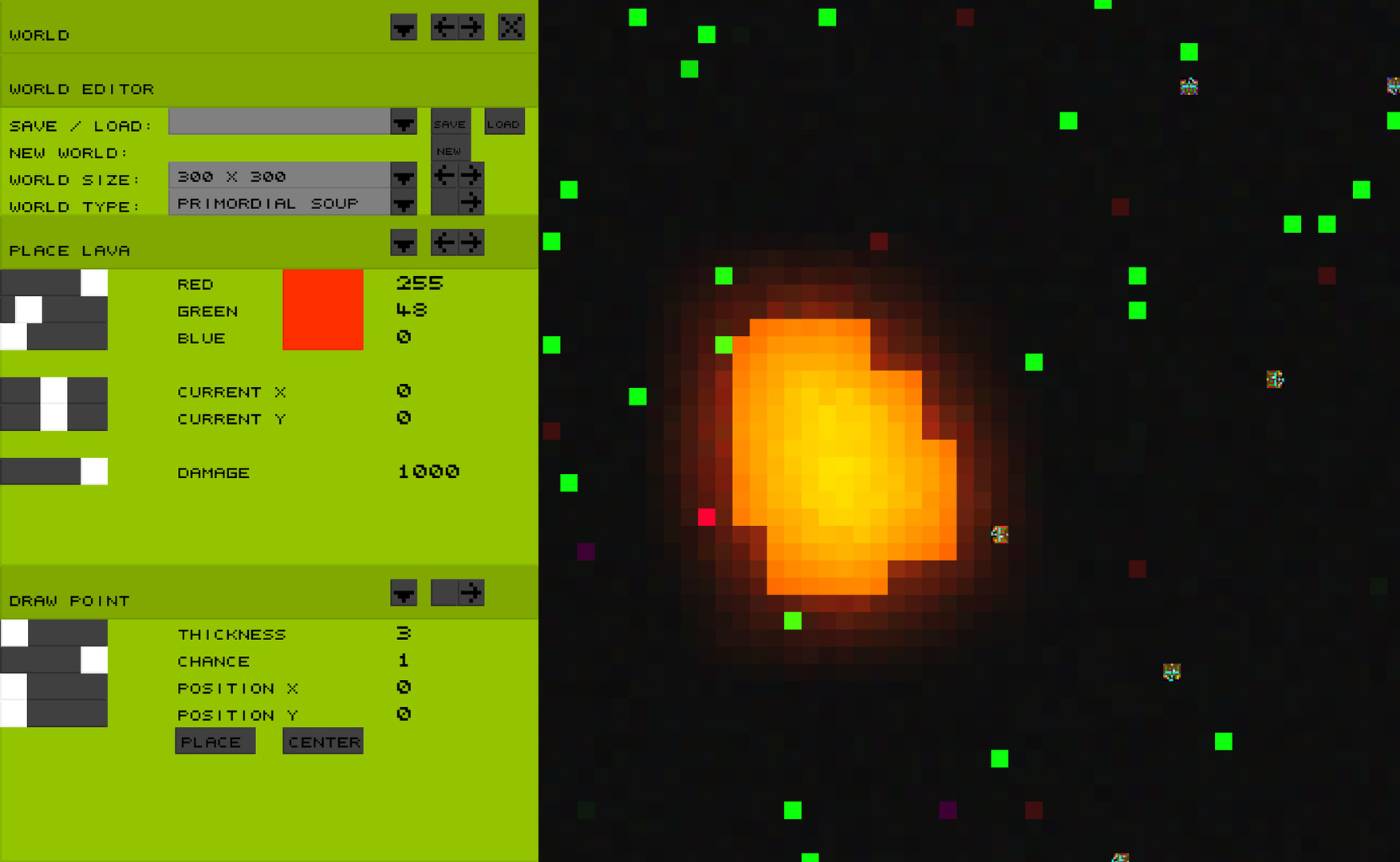Gridworld is an artificial life / evolution simulator in which abstract virtual creatures compete for food and struggle for survival. Conditions in this two-dimensional ecosystem are right for evolution to occur through natural selection.
Creatures live short and replicate fast. Evolution can therefore be observed in hours or days instead of thousands of years.
how does it work?
Creatures in Gridworld are a simple and abstract versions of biological life. They can be recognized as colored blocks moving around the grid. Just like in nature,
creatures have DNA, a digital code that describes the morphology of the creatures. in Gridworld, the dna describes the morphology of the neural network (brain) of the creature. In turn, the brain decides how the creature behaves during its life.
When a piece of dna is copied when creatures reproduce, there is a small chance of mutation in the dna. This leads to diversity in the dna pool. Natural selection causes those creatures with the best adapted genes to have more offspring. This causes the best adapted genes to increase in numbers while the weaker genes are decreasing in numbers and are eventually rooted out.
Through this process of natural selection, creatures become increasingly well adapted to their environment within each generation. And thus, evolution occurs.
How to use it?
The cool thing about evolution is that it is an autonomous process that requires no guiding hand.
You can simply start a simulation and take your hands of completely. When you come back to check after a day or two, you will find a thriving eco system of virtual creatures. You can do more than just simply observing though. Gridworld's simulations are highly customizable. The user interface allows you to tweak any simulation parameter or change the environment as you like.
This way you can set up your own experiments and watch as your creatures adapt to the world and conditions that you provide for them.
what is the goal?
Gridworld is not a game but an evolution simulator.
There is no real goal in Gridworld other than playing, learning, observing and experimenting.
The role of the user is mainly passively observing the process of evolution as it unfolds in the simulation.
EDIT: I just found out v1.12 is broken, so I had to revert back to 1.11. The external JRE is still used which means that the save and load crashes should be fixed, but the other points mentioned below are currenty not in gridworld.
I am pleased to announce the release of Gridworld v1.12. This patch contains two important fixes and a bunch of small bug fixes and improvements.
- JRE has been included in the Gridworld folder, which means that users no longer have to install java serperately. It also means that everyone is using the same java version. This most likely means that crashes during saving and loading are solved. I can't say this for certain because I can't test this, but that is what I suspect.
- I have done some major memory optimizing. This should lead to less memory use, smaller file size of saved world and also less chance of crashes for those who experienced random crashes. Unfortunately this also means the old gridworld saved world files and saved creature files are now corrupt. exported creatures will still work.
Other changes in this patch are:
- Fixed bug in which carcasses could replace other objects on the grid
- Added maximum carcass slider to carcass window in world editor.
- Made documentation. (see folder)
- Fixed bug in which creatures would not die if they overfeed
- Carcasses now turn darker when they are being eaten.
- Fixed bug in which placing someting on the far right side or top of the grid did not work.
- The color brightness of carcasses which is relative to the color of the creature can now be manually changed in the UI
- Auto apocalyps. Meteors can now be dropped automatically.
- Fixed bug in which settings in the world editor where not saved for tiles,rocks,carcasses and lights.
- Carcass settings now has a separate window.
EDIT: I just found out v1.12 is broken, so I had to revert back to 1.11. The external JRE is still used which means that the save and load crashes should be fixed, but the other points mentioned below are currenty not in gridworld.
I am pleased to announce the release of Gridworld v1.12. This patch contains two important fixes and a bunch of small bug fixes and improvements.
- JRE has been included in the Gridworld folder, which means that users no longer have to install java serperately. It also means that everyone is using the same java version. This most likely means that crashes during saving and loading are solved. I can't say this for certain because I can't test this, but that is what I suspect.
- I have done some major memory optimizing. This should lead to less memory use, smaller file size of saved world and also less chance of crashes for those who experienced random crashes. Unfortunately this also means the old gridworld saved world files and saved creature files are now corrupt. exported creatures will still work.
Other changes in this patch are:
- Fixed bug in which carcasses could replace other objects on the grid
- Added maximum carcass slider to carcass window in world editor.
- Made documentation. (see folder)
- Fixed bug in which creatures would not die if they overfeed
- Carcasses now turn darker when they are being eaten.
- Fixed bug in which placing someting on the far right side or top of the grid did not work.
- The color brightness of carcasses which is relative to the color of the creature can now be manually changed in the UI
- Auto apocalyps. Meteors can now be dropped automatically.
- Fixed bug in which settings in the world editor where not saved for tiles,rocks,carcasses and lights.
- Carcass settings now has a separate window.
Minimum Setup
- OS: 64-bit Ubuntu or equivalent
- Processor: 2.0 Ghz Quad Core CPUMemory: 8 GB RAMStorage: 200 MB available spaceAdditional Notes: Java has to be installed separately
- Memory: 8 GB RAMStorage: 200 MB available spaceAdditional Notes: Java has to be installed separately
- Storage: 200 MB available spaceAdditional Notes: Java has to be installed separately
Recommended Setup
- OS: 64-bit Ubuntu or equivalent
- Processor: 2.0 Ghz Quad Core CPUMemory: 8 GB RAMStorage: 500 MB available spaceAdditional Notes: Java has to be installed separately
- Storage: 500 MB available spaceAdditional Notes: Java has to be installed separately
[ 6487 ]
[ 2143 ]
[ 1910 ]




















































